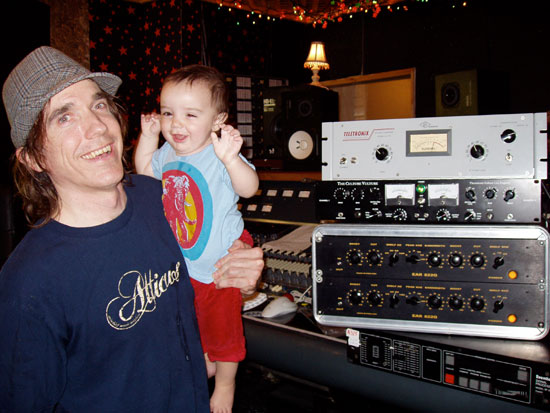Analog Dialog: Jimmy Boyle Returns to the Craft of Engineering
|
|
|
Jimmy Boyle and his son Atticus with some of their favorite gear
|
Jimmy Boyle is one of these analog fiends, and a charming fiend at that. Jimmy also had one of most amazing opportunities to learn the business. He spent seven years in the nineties working with Producer extraordinaire Rick Rubin, basically assisting Rick with everything including pre-production, A & R, engineering, production, and mixing.
Jimmy had started as a musician and guitar player. He came to LA in search of fame and fortune.
"The thing that really made the vocals different was the LA-2A."
"I became discouraged because every band I worked with just wanted to be like another band instead of being unique. Whatever the hot band of the moment was - like Soundgarden - that's what they wanted sound like. I decided that I would rather be a producer so that I work with a lot of different people and different genres of music."
The experience with Rick provided Jimmy the opportunity to work on many record and with many different producers and he basically learned engineering from watching and doing.
One of Jimmy's breakthrough projects was mixing the number one Alanis Morisette single, You Ooughta Know. "The music they gave me was totally different than my final mix. I wanted her voice to be really aggressive. The original song and music was very different so I had Dave Navarro and Flea come down and redo everything. We used the LA-2A on Flea's bass. The thing that really made the vocals different was the LA-2A. It made that really aggressive sound on her voice. We tried to overdrive the signal. That is the only product that could have given it that sound."
"I was doing a mix the other day with a new artist and the vocals didn't sound right. It didn't sound aggressive, he needed some oomph. I realized that I had to try an LA-2A. I thought we were going to have to re EQ everything, but the only thing we did is send it through the 1176 to the LA-2A and it worked. It was incredible."
Jimmy's now producing a new all-star band in his home studio. The #1 Prescribed Sleep Aid consists of Roger Manning (Jellyfish, Beck, Air) on keyboards, Justin Meldal Johnsen (Beck, Tori Amos, Air, Garbage) on bass, drummer Norm Block (Fred Durst, Rasputina, Plexi) and a host of different singers. They tracked seven tracks at Sound City - all the drums and bass, and three songs at Jimmy's house.Jimmy's home studio is centered around a Neve 8028 (which is also what he uses at Sound City), Pro Tools, Yamaha NS-10 monitors, Meyer HD-1 and of course an LA-2A and 1176 plus many vintage compressors.
His standard vocal chain for this project is an 1176 in conjunction with an LA-2A. He sees this as the perfect combo because you can adjust the attack and release settings on the 1176.
"The LA-2A gives it dimension. The 1176 is great because it's idiot proof. It's really hard to mess up your signal with one but it's also a really precise tool."
Jimmy likes to track to tape. He does minimal editing in Pro Tools and mixes on the Neve. He doesn't believe in processing the sound in Pro Tools because he doesn't feel that you can accurately hear what Pro Tools is doing. "I was working on one project and they sent me a mix done in Pro Tools and it sounds like paper. There's no dimension, it sounds like a sheet of paper."
"You can't get dimension when you're mixing in the box. One of the things about everybody having a home studio with Pro Tools and recording their own music is that people forget about the art of engineering. I get stuff all time to mix that people have recorded on their own in Pro Tools and I don't know how I am going to fix it. You can't really mix if you have to fix it."
A career highlight for Jimmy was mixing John Frusciante's solo album.
"He recorded it on a four track mini disc. Those things sound horrible. It's the worst sounding recording medium every made. I spent a lot of time and I think the final record sounds pretty good. I am really proud of that project."
"I took it all out of the mini disc and put it all on tape - my Studer A80 Mark 4. I had a Neve Melbourne 12 channel console. I made some EQ adjustments before sending it to tape. Then I went from tape to into Pro Tools and started cleaning up the tracks and then I went back to the Studer and mixed it on a Neve at Hollywood Sound. I multed out a lot of channels and tried to build dimension. It took a lot of work. It's has a nice quality and doesn't sound like a demo."
Jimmy just invested in two more LA-2As and two 1176s so stay posted for more.
- Marsha Vdovin
Questions or comments on this article?
